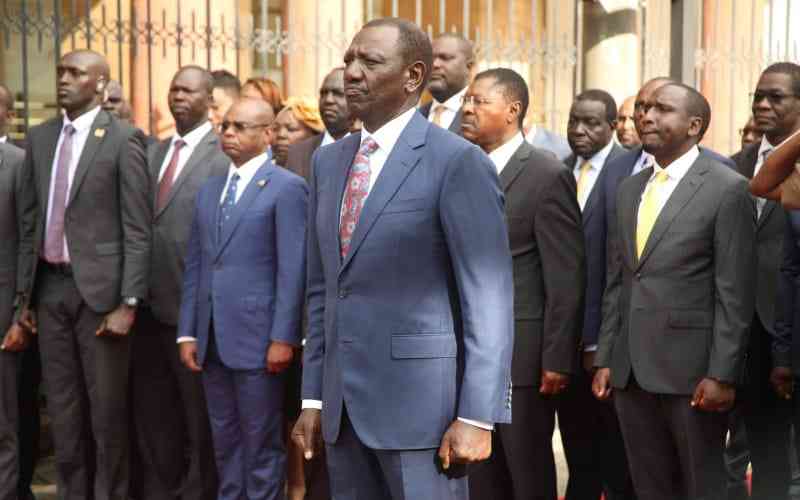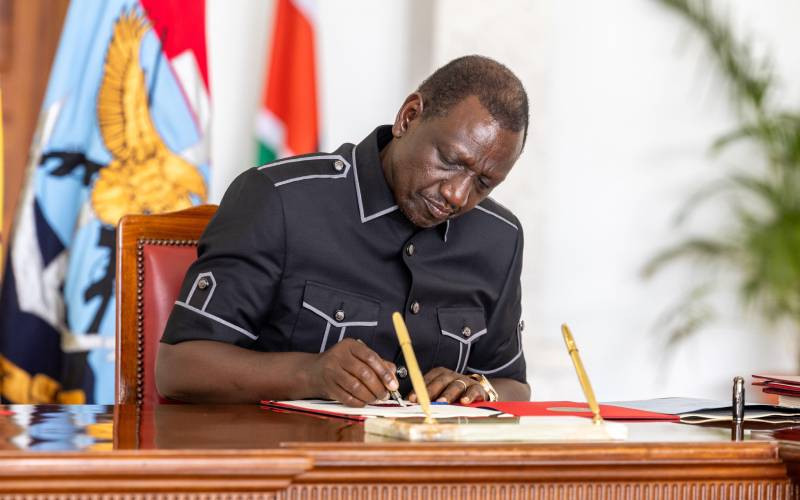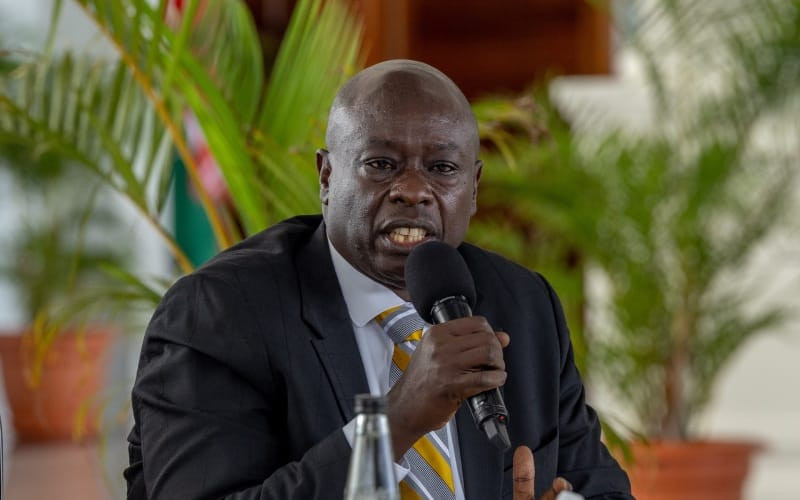
When Mogadishu residents ask about Kismayo, they do not ask about the Al-Shabaab, just about the drought-induced starvation and whether it's killing as many people as they see on television.
Kismayo has remained largely peaceful since its liberation. Traffic inside the city is moderate, business is booming, and buildings are under construction.
There isn't much talk about the war, about the Al-Shabaab.
"Al-Shabaab (wa)meenda kabisa (Al-Shabaab is completely gone)," Farah Mohamed, a local, says.
Residents of Kismayo, such as a Kenyan living and working there who only identified himself as Francis, also learn the goings-on of the country's capital, 486km to the North East, from news bulletins.
"It mostly involves an al-Shabaab attack," he says, confessing to dread the frequent trips his job demands he makes to Mogadishu, where I had been before visiting Kismayo, where I would later return. He asks whether the guns and bombs have fallen silent there like they largely did in his new town. They haven't.
The nation's capital, like much of the country, has been zoned into the green, blue and red zones, based on the threat level of an Al-Shabaab attack.
The green zone is secured by the Somali National Army (SNA) and Somali National Police (SNP) on the outer borders and African Union Transition Mission in Somalia (ATMIS) forces on the inner rings. Concrete and sand barriers secure all the layers.
The green zone is safe enough for one to leave their body armour behind, safe enough to jog in the streets, if you don't mind the baking heat. Temperatures in the capital can soar to as high as 40C.
Most of the things that make Mogadishu a city, the capital, are located in the green zone - the international airport, luxury hotels, office buildings, foreign missions.
More buildings are coming up. And so are higher, thicker walls, more concrete barricades and sand barriers.
Renovation works are ongoing on some of the city's walls, much of which involves masking bullet holes with fresh layers of cement.

With a sophisticated weapon defence system, few mortars penetrate the green zone. Sounds of gunfire do. On most days and nights, they will intermittently ring out from a distance.
"The sound of gunfire here is like the sound of crickets in Nairobi," a Kenyan ATMIS civilian officer says.
Most of the gunfire is caused by the city's traffic officers. In the narrow roads of Mogadishu, traffic tends to build up quickly.
Tuktuk drivers, who will park their vehicles at any spot, are the usual culprits causing the jams. Traffic clogs make the police an easy target for the Al-Shabaab. And so they fire in the air to clear a build-up.
Sometimes the gunfire results from the SNP executing criminals on the designated execution fields.
Many times, it's them, jointly with the SNA and ATMIS forces, firing at the al-Shabaab and the al-Shabaab firing back.
Persistent gunfire is every green zone resident's signal to seek refuge inside a bunker. Virtually all buildings in this zone have a bunker or two, made of the thickest walls and with as heavy a door as can be made.
Besides the usual gunfire is the occasional IED attack.
A September attack in Barsa, 30 km off Mogadishu, claimed the life of General Farxaan Mohamud, the head of the Mogadishu police, and a journalist.
A month earlier, several mortar explosions hit the capital, targeting the nation's Parliament, which had met to approve Cabinet nominees. The Al-Shabaab staged similar attacks targeting Parliament in April. Nine KDF troops died in an IED attack in Gherille in March. In January, an IED attack in the capital killed eight people.
More recent attacks have been executed in other regions of Somalia. They include twin vehicle-borne IED attacks in Beletweyn earlier this month that killed several people well as an attack in Hiraan last month that killed civilians.
The terrorist group has suffered losses on their side, too. An ATMIS operation in Hiraan in August killed 244 Al-Shabaab fighters, with another last week killing 60 in the same region.
The Somali forces were part of the two operations. In two years, they will be on their own in conducting such operations, in the event the Al-Shabaab situation will persist. Whether or not they will be ready to take over fully is still debatable.
The official position is that there is good progress, even though it has not been "as much as we should have", as Ms Lortan explains.
"There have been serious delays in implementing the first phase, majorly because of the prolonged election period... four months were lost," she says about the time it took to have a government in place since the election that began in November last year, dragging on to May this year. They had been scheduled to end in December last year.
The first phase incorporates a reconfiguration into ATMIS. The second involves joint operations and the handing over of some operating bases to Somali forces. Phase Three will see ATMIS hand over the remaining bases with the final phase being the withdrawal of ATMIS.
The Somali forces have taken over certain duties, such as manning the gates of their international airports in Kismayo and Mogadishu as well as securing their cities. SNP officers, as well as those from federal police units, such as the Jubaland Police Force, join KDF forces in patrols of Kismayo. And they are taking charge of meetings at the Joint Operation Centres in the different sectors, where their generals urge utmost cooperation and secrecy in fighting Al-Shabaab.
"If things go on as they are, we will hand over to Somalia in 2024," Lt Gen Diomede Ndegeya, the ATMIS force commander, says, even as he admits that the ATMIS forces are overstretched and are finding it difficult to expel the Al-Shabaab from some of their sanctuaries. "Covering a coastline of 3,600 km is difficult... we are unable to do certain operations."
A government-led denunciation of the Al-Shabaab is also said to be working. Several militia groups and citizens have heeded President Hassan Sheikh Mohamud's call to jointly fight the Al-Shabaab.
"The population is supporting the government. That, to me, is a game-changer," says Maj Gen Wilson Kitsao Shume, the ATMIS deputy force commander. "We have to ensure that the Al-Shabaab will not galvanise support. If we are successful in doing that, there will be no Al-Shabaab by the end of 2023."
ATMIS force spokesperson Lt Col Abdullahi Ganale describes the al-Shabaab fighters as more of "bandits", given their diminishing fortunes.
The ATMIS police component has also enjoyed successes in warding off radicalisation and violent extremism, as well as in making the SNP efficient.
"When we came here, we had very few functional police stations," says police Senior Superintendent Ndili Alex Munyao, the commander of the Kenya contingent. "Nine new police stations have been constructed, renovated and equipped since 2016."
Despite such optimism from the top, the overriding feeling, even among Somali forces, is that the local forces will probably need much more time.
"Mbona aache sisi? Hapana acha sisi (Why should they - ATMIS forces - abandon us? They shouldn't abandon us," Warsame Ahmed, the Kismayo Central Police Commander says when I raise the subject of the KDF's imminent departure. "Aende 2026 (The earliest they should leave is 2026)."
Ms Lortan says that the Somali government has already informed them that they won't be ready for the first drawdown of 2,000 troops.
"If we withdraw before they are ready to take over, we might create an opening for the al-Shabaab... there is always the possibility of an extension," she says.
Some of the ATMIS personnel we spoke to, some of whom are unauthorised to talk to the press, say that their Somali forces are yet to fully conform to the strict requirement of hierarchical discipline and that they lack a sense of patriotism, choosing instead to submit to a clan-based system, through which disputes as grave as rape and murder are resolved.
"They will need a serious mindset transformation if they are to take charge," a police officer from Zambia said.
But there is a feeling that the younger generation, which forms the majority of the Somali forces, is losing interest in the clan-based system and is embracing a nationalistic outlook of their country.
Other concerned soldiers feel that Somalia has been babied too much for far too long. A soldier who held this view said he did not understand what the cause of the perpetual conflict was and why a resolution was long in coming.
"Maybe if we left them alone they would find a solution," he said. "Even a child has to leave their parents' house and find their path."
But the notion is quickly rejected, given the expansionist tendencies of the Al-Shabaab, which over-ambitiously seeks to establish an Islamic caliphate on earth.
"We have seen the spillover of what happens in Somalia in Kenya... Even if we leave them, the Al-Shabaab won't leave us," Ms Lortan says.
There is also the concern that Somalia will become another Iraq or Afghanistan with the exit of ATMIS forces, and that the Al-Shabaab will overrun the country's government and its security apparatus.
Lt Gen Ndegeya says that the ATMIS strategy is different from the one employed in Afghanistan.
"In Afghanistan, they did some offensive operations, without training Afghan forces to hold the terrain," he says. "We don't leave any forward operating base without seeing to it that Somali forces can handle it defensively."

Such concerns stem from the fact that some of the officers trained to join the army or the police often defect to Al-Shabaab, which found a unifying factor - radical Islam - long before the government did so. And that's how they have been as successful as to collect 'zakat', now amounting to an estimated Sh1.8 billion monthly. There is no telling how many more Somali soldiers will defect to Al-Shabaab in future.
Within ATMIS, the challenges range from a language barrier, caused by the conflation of security forces from nine different countries, and insubordination, owing to conflicting loyalties. The biggest challenge, however, is funding, which threatens to claw back the gains made thus far.
The European Union contributes the lion's share of the ATMIS funding, an amount that totals more than Sh200 billion since the start of the AU effort in Somalia.
"The EU has made it clear that donor fatigue has set in... they are funding the resolution of a conflict that is not in their backyard," Ms Lortan says. "At the end of the day, Somalia has to take control of itself. It wants to."
Funding is also a problem for the Somali forces, who often have to sit out some patrols and operations as they sometimes lack fuel for their vehicles. Most officers also lack things as basic as uniforms and have to work with whatever they can find, which are often the colours of a foreign military. And so a large portion of the government forces operate without insignia, a potential danger in the face of armed conflict.
Capping it all is the ongoing Russia-Ukraine conflict that has seen Russian helicopters grounded as part of UN sanctions against the nation, paralysing some strategic ATMIS activities.
KDF soldiers will perform the same drill as they exit Kismayo after their patrol, keeping all but one opening shut until they leave the storeyed buildings of the town.
"Unaweza tupiwa mzigo (someone could hurl in 'luggage')," one soldier jokes as he urges a comrade close to the rear door to shut it well. He is referring to an explosive, most probably a mortar or grenade. They all crack up, but the laughter is short-lived.
After checking that everyone who joined them on the patrol is aboard the two APCs and the humvee, they abandon the sandy paths for the lone tarmac that leads to their base. There is silence once again and their eyes resume their scanning.
Some are scheduled for a break this coming week, the first in months, and will fly home to Kenya or hitch a ride with one of the KDF supplies lorries. In two years, those who will be on tour will make the trip out of Kismayo and Dhobley, and wherever else more are stationed, out of the arid plains of Somalia, one last time.
While some will return home with scars, hundreds, who joined the war healthy and strong, will have made that journey inside body bags. That's what war does. It maims. It kills. Many Kenyan soldiers have died on the frontline, before and after the El Adde attack in 2016. For the love of their country, death is a price they pay with pride.
"It is in our interest to ensure that Kenyans are safe," says Colonel Joel Maiyo, the Sector Two deputy sector commander. "Protecting our nation is worth every sacrifice."
 The Standard Group Plc is a multi-media organization with investments in media platforms spanning newspaper print
operations, television, radio broadcasting, digital and online services. The Standard Group is recognized as a
leading multi-media house in Kenya with a key influence in matters of national and international interest.
The Standard Group Plc is a multi-media organization with investments in media platforms spanning newspaper print
operations, television, radio broadcasting, digital and online services. The Standard Group is recognized as a
leading multi-media house in Kenya with a key influence in matters of national and international interest.











